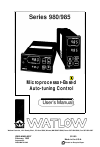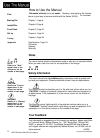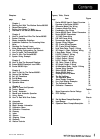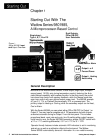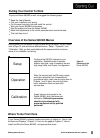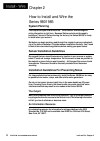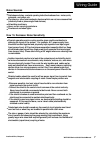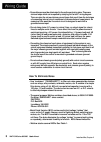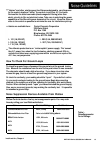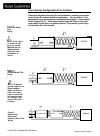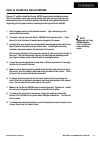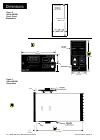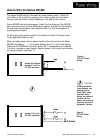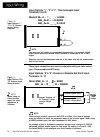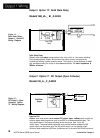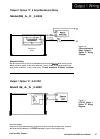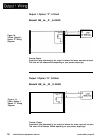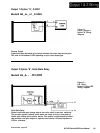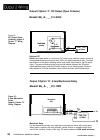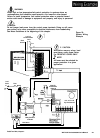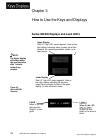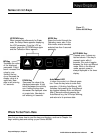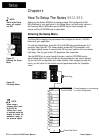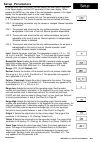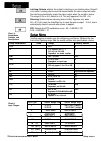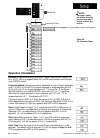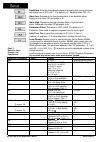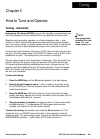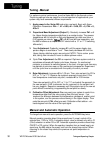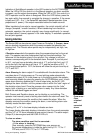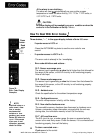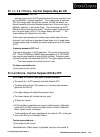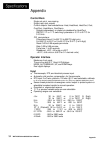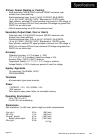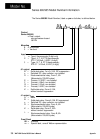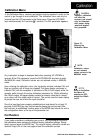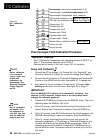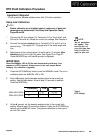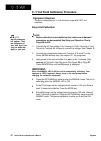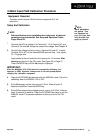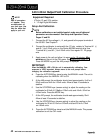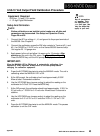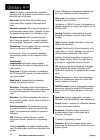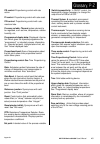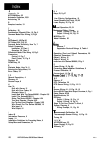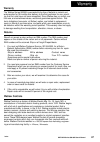- DL manuals
- Watlow
- Controller
- 980 Series
- User Manual
Watlow 980 Series User Manual - Model# 98_A-_H _0-0000
Output 1 Option “H”, O-5VDC
Model# 98_A-_H _0-0000
Process Output
Proportional value determined by the control to balance the sensor input and set point.
This value will fall between O-5VDC dependlng on your process output type.
Output 2 Option “B”, Solid State Relay
Model# 98_A-
B 0-0000
- -
Solid State Relay
Watlow’s solid state relays change state at zero volts, which is zero-cross switching.”
They are also optically isolated, which means the output circuitry is energized by
infrared light striking a photo-sensitive device. This results
in
virtual absence of electri-
cally
generated noise,
plus output to input
electrical isolation.
Off state impedance is
2 O K o h m s minimum.
Figure 20 -
O-5VDC, Output 1,
Option "H" Wiring
Diagram.
Figure 21 -
S.S. Relay,
Output 2, Option "B"
Wiring Diagram.
Install and Wire, Chapter
2
WATLOW Series 980/985 Users Manual
19
Summary of 980 Series
Page 1
Microprocessor-based auto-tuning control user’s manual) watlow controls, 1241 bundy blvd., p.O. 8ox 5580, winona, mn 55987-5580, phone: 507/454-5300, fax: 507/452-4507 w985-ma58-9307 february, 1993 supersedes: w985-ma70-9043 $10.00 made in the u.S.A. Printed on recycled paper.
Page 2: Notes
How to use the manual first.. Starting out install/wire front panel set up tuning appendix note: details of a *‘note** appear here, in the narrow box on the outside of each page. Caution: details of a “caution” appear here, in the narrow box on the outside of each page. Warning: details of a “warnin...
Page 3
Chapters figures, table, charts page item page item 4 starting out with the watlow series 980/985 4 general description 5 putting your control to work 5 overview of the series 980/985 menus chapter 2 6 6 6 6 7 9 9 10 11 13 21 how to install and wire the series 980/985 system planning sensor installa...
Page 4: General Description
Chapter 1 flgure 1 - series 980/985 input and output overview starting out with the watlow series 9801985, a microprocessor-based control single input - type j, k, t, n or pt2 dual outputs- pid or on/off user selectable heat, cool or alarm output 1 or 2 percent power output 1, heating auto-tuning ge...
Page 5: Putting Your Control to Work
Putting your control to work to put your series 980/985 to work, we suggest the following steps: read the user’s manual. Plan your installation and wiring. Cut the panel mounting hole and install the control. Wire your series 980/985 to the system. Start the system and tune the series 980/985. Make ...
Page 6: System Planning
Chapter 2 how to install and wire the series 9801985 system planning this chapter tells you how to install the series 980/985. All mounting and wiring information is right here. Because watlow controls are thoroughly tested and "burned in" before leaving the factory, the series 980/985 is ready to i...
Page 7: Noise Sources
Noise sources switches and relay contacts operating inductive loads such as motor, coils, solenoids, and relays, etc. Thyristors or other semiconductor devices which are not zero crossover-fired (randomly-fired or phase angle-fired devices). All welding machinery. Heavy current carrying conductors. ...
Page 8: How to Eliminate Noise
• ground loops must be eliminated in the entire control system. There are obvious loops which can be spotted by studying the"as-built" wiring diagram. There are also the not-so-obvious ground loops that result from the technique of connecting internal circuit commons in the manufacturer's equipment....
Page 9
"islatros" and other similar power line filters are designed to carry the power for the control circuit and “buffer” the control circuit from a.C. Line noise. Devices like the lslatrol use media (electromagnetic filtering) other than electric circuits to filter out electrical noise. Take care in mat...
Page 10
Line filtering configurations for controls figure 3 - these three diagrams show you filter configurations for removing input power noise. Choose the one best suited for your system. For very dirty or critical applications - use a microcomputer-regulated power supply or uninterruptable power supply (...
Page 11
How to install the series 980/985 figures 6,7 and 8 provide the series 980/985’s panel cutout and dimensions. Do not, however, make your panel cutout until you are sure that you are placing the control in the best location. Read the noise guidelines at the beginning of this chapter before installing...
Page 12
Figure 6 - series 980/985 panel cutout dimensions panel cutout max. Panel thickness 0.50 (12.7mm) 3.82 +0.03 - 0.00 (92mm + 0.8) load power indicators panel .89 (48.0 mm figure 7 - series 980/985 dimensions 12 watlow series 9801985 user’s manual ‘install and wire, chapter 2.
Page 13
How to wire the series 980/985 the series 980/985 wiring is illustrated by model number option. Check the unit sticker on the control and compare your model number to those shown here and also the model number breakdown in the back of this manual. Series 980/985 internal circuits appear “inside“ the...
Page 14: Terminals 18 & 20
Figure 10 - input options “1”, **2* & *3’, thermo- couple wiring diagram. Flgure 11 - input options "2" & "3" process input wlring diagram. Note: when using a 4- 2oma process input, the input impedance is 2 4 9 o h m s lnput options “1 “, “2” & “3”, thermocouple input terminals 18 & 20 model # 98 – ...
Page 15: Terminals 12 - 14
Input options “2” & " 3 " rtd - 2 wire terminals 12 - 14 modei#98 _ a - 2 _ _0-0000 98_a-3_ _0-0000 jumper#l3to#l4 input options “2” & " 3 " rtd - 3 wire terminals 12 - 14 model# 98_a-2_ _ 0-0000 98_a-3_ _0-0000 . . . . . . - note: long lead lengths create electrical resistance. There will be a 1° a...
Page 16: Output
Output 1 option “b”, solid state relay figure 14 - solid state relay, output 1, option “b” wiring diagram. Figure 15 - dc output 1 (open collector), option 72” wiring diagram. Modei# 98_a-_ b _0-0000 solid state relay solid state relay watlow's solid state relays change state at zero volts, which is...
Page 17: Model#98_A-_D _0-0000
Output 1 option “d”, 6 amp mechanical relay model#98_a-_d _0-0000 mechanical relay mechanical relay the electromechanical relay is an electrical and mechanical with moving parts. When power is applied to the relay solenoid, contact closure is created through move- ment of the “common” contact of the...
Page 18: Model# 98_A-_F _0-0000
Figure 18 - 4-2oma, output 1, option "f" wiring diagram. Figure 19 - 0-20ma, output 1, option “g” wiring diagram. Output 1 option “f", 4-20ma model# 98_a-_f _0-0000 process output proportional value determined by the control to balance the sensor input and set point. This value will fall between 4-2...
Page 19: Model# 98_A-_H _0-0000
Output 1 option “h”, o-5vdc model# 98_a-_h _0-0000 process output proportional value determined by the control to balance the sensor input and set point. This value will fall between o-5vdc dependlng on your process output type. Output 2 option “b”, solid state relay model# 98_a- b 0-0000 - - solid ...
Page 20: Model# 98_A-
Figure 22 - dc output (open collector), output 2 option "c" wiring diagram. Figure 23 - 6 amp mechanical relay, output 2, option "d" wiring diagram. Output 2 option “c", dc output (open collector) model# 98_a- c 0-0000 __ 9 - 8 heat, cool + or alarm switched dc watlow’s solid state switch is a low c...
Page 21
Warning: install high or low temperature limit control protection in systems where an overtemperature fault condition could present a fire hazard or other hazard. Failure to install temperature limit control protection where a potential hazard exists could result in damage to equipment and property,...
Page 22
Chapter 3 note: the upper display will always show the process value after 1 minute without key strokes. Figure 25 - series 980/985 displays how to use the keys and displays series 980/985 displays and load led’s upper display red, 0.3” high led, seven segment, three or four digit display indicating...
Page 23: Series
Series 980/985 keys figure 27 - series 980/985 keys up/down keys mode key when pressed simultaneously for 3 sec- steps the control through the onds, the setup menu appears displaying operating menu; also, in the the loc parameter. From the loc pa- auto mode, enters new data rameter, press the up/dow...
Page 24: Entering The Setup Menu
Chapter 4 note: while in the setup menu, all outputs are off. Figure 27 - entering the setup menu. Figure 28 - the setup menu. Note: when using a process input such as o-5vdc or 4-2oma, the rl and rh settings scale the display to match the measured range of the process signal. How to setup the serie...
Page 25: Setup Parameters
Setup parameters at the top of the menu, the series 980/985 displays the user level of operation in the upper display, and the loc parameter in the lower display. When pressing the mode key, the value of the next parameter appears in the upper display, and the parameter itself is in the lower displa...
Page 26
Latching: selects whether the output is latching or non-latching when output 2 is an alarm. Latching alarms must be cleared before the alarm output will reset. Non-latching automatically resets the alarm output when the condition clears. The range is lat or nla, default is nla. This only appears if ...
Page 27: Operation Parameters
Mode key control set point note: the upper display will always show the process value after 1 minute without key strokes. = prompt appears or not according to control configuration. . Operation parameters set point 2: sets the operating set point for output 2 when control mode is ht/ ht or cl/cl. Sp...
Page 28
Chart 3 - operation menu prompts and descriptions. Dead band: enter the dead band between the heating and cooling functions adjustable from ± 99°f/± 55°c. The default is 0°. Appears when ot2 = cl. Alarm low: represents the low process alarm or low deviation alarm. Displayed only when 0t2 parameter i...
Page 29: Tuning - Automatic
Chapter 5 how to tune and operate tuning - automatic auto-tuning: the series 9801985 gives you the capability to automatically tune the pld parameters to fit the characteristics of your particular thermal system. The auto-tuning procedure operates on a thermal response value - slow, medium, or fast....
Page 30: Tuning - Manual
Tuning - manual for optimum control performance, tune the series 985 to the thermal system the tuning settings here are meant for a broad spectrum of applications; your system may have somewhat different requirements. 1. 2. 3. 4. 5. 6. Apply power to the series 965 and enter a set point. Begin with ...
Page 31: Using Alarms
Indication of auto/manual operation is the led located on the auto/man key. When the led is on, the control is in the manual operation, an alarm condition is present, and the output de-energizes. When the led is off, the control is in auto operation and the alarm is energized. When the led flashes, ...
Page 32: How to Deal With Error Codes
Press ~ twice- read error figure 32 - error code display examples note: electrical noise or a noise event, vibra- tion or excess environmental moisture or tem- perature may cause series 985 errors to occur. If the cause of an error is not otherwise apparent, check for these. •if the alarm is non-lat...
Page 33
Er 1, 2, 3 & 7 errors - control outputs may be on if operator access is loc 0 or 1 . . . . ..And the control was in auto operation when the error occurred, it will go into manual (% power) operation. If the output power is less than 70%±5% change within the last two minutes, the 985 will switch into...
Page 34: Control Mode
Appendix control mode • single set point, non-ramping. L single input, dual outputs. L control outputs: user selectable as: heat, heat/heat, heat/cool, cool, cool/cool, heat/alarm, cool/alarm l outputs independent, or related via deadband for heat/cool. L on/off: 3°f or 1 .7°c switching hysteresis o...
Page 35: Accuracy
Primary output (heating or cooling) l solid state relay, 0.5a @ 24vac minimum, 253vac maximum, opto- isolated, zero cross switching. L electromechanical relay, form c, 6a @ 115/230vac, 6a @ 28vdc, 1/8 hp. @ 115vac 125va @ 115vac. Warranted to 100,000 cycles. L open collector, switched dc signal prov...
Page 36
Series 980/985 model number information the series 980/985 model number, listed on your unit sticker, is defined below. Control series 980/985 = dual output, microprocessor-based i/8 din mounting 0 = horizontal 5 = vertical input 1 = 2 = 3 = type j thermocouple (3 digit only) type j, k, t, n, pt 2 t...
Page 37: Calibration Menu
Calibration menu in the calibration menu, various input signals must be supplied in order for the control to go through its auto calibration. The calibration menu can only be entered from the loc parameter in the setup menu. Press the up/down keys simultaneously for 3 seconds 1 second). The cal para...
Page 38: Equipment Required
Figure 34 - the calibration menu. Note before calibration on an installed control, make sure all data and parameters are documented. See setup and operation charts, pages 26 and 28. Note: not all parameters will appear. They are dependent on your unit type. Use only the steps that apply to your unit...
Page 39: Equipment Required
Rtd field calibration procedure equipment required l 1k ohm precision decade resistance box with 0.01 ohms resolution. Setup and calibration note before calibration on an installed control, make sure all data and parameters are documented. See setup and operation charts, pages 26 and 28. 1. Connect ...
Page 40: Equipment Required
Note: not all parameters will appear. They are dependent on your unit type. Use only the steps that apply to your unit. 0 - 5 volt field calibration procedure equipment required l precision voltage source 0-5 volt minimum range with 0.001 volt resolution. Setup and calibration note 1. 2. 3. Before c...
Page 41: Equipment Required
4-20ma input field calibration procedure equipment required l precision current source 0-20ma minimum range with 0.01 ma resolution. Setup and calibration note note: not all parameters will appear. They are dependent on before calibration on an installed control, make sure all data and your unit typ...
Page 42: Not
0-20/4-20ma output field calibration procedure note not all parameters will appear. They are dependent on your unit type. Use only the steps that apply to your unit. Equipment required l 470 ohm 1/2 watt 10% resistor. L 4 - 1/2 digit digital multimeter. Setup and calibration note 1. 2. 3. Before cal...
Page 43: Equipment Required
0-5/0-10 volt output field calibration procedure equipment required l 20k ohm, 1/4 watt, 10% resistor l 4 - 1/2 digit digital multimeter. Setup and calibration note note: not all parameters will appear. They are dependent on your unit type. Use only the steps that apply to your unit. 1. 2. 3. Before...
Page 44
Alarm: a condition, generated by a controller, droop: difference in temperature between set indicating that the process has exceeded or fallen point and stabilized process temperature. Below the set or limit point. Duty cycle: percentage of “load on time” anti-reset: control feature that inhibits au...
Page 45
Pd control: proportioning control with rate action. Pi control: proportioning control with auto-reset. Pid control: proportioning control with auto- reset and rate. Process varlable: thermal system element to be regulated, such as time, temperature, relative humidity, etc. Programmed display data: d...
Page 46
A appendix , 34 auto/man key, 23 automatic operation, 23,31 auto-tuning, 30 k, l keys, 23, fig. 27 line filtering configurations, 10 local-remote set point, 25,28 ’ b bumpless transfer, 31 lower display, 22, fig. 25 c calibration, 38 combination differential filter, 10, fig. 5 common mode fitter wir...
Page 47: Warranty
Warranty the watlow series 980/985 is warranted to be free of defects in material and workmanship for 36 months after delivery to the first purchaser for use, provid- ing that the units have not been misapplied. Since watlow has no control over their use, and sometimes misuse, we cannot guarantee ag...

